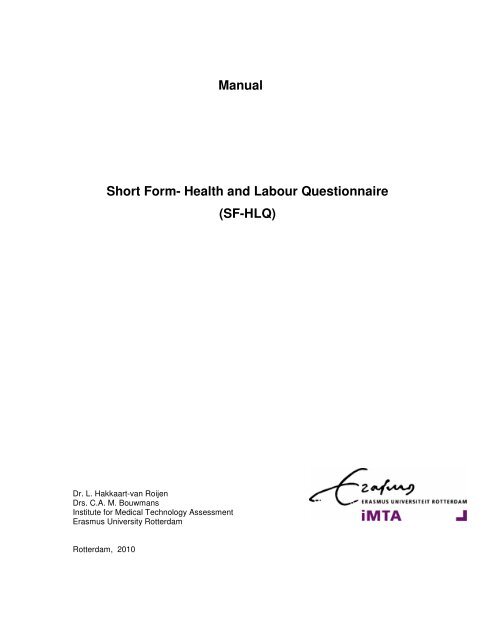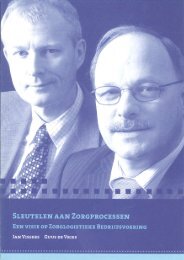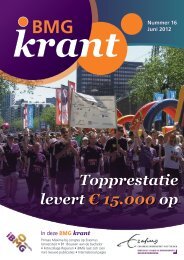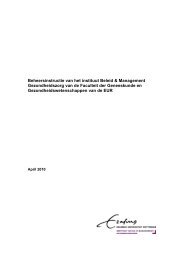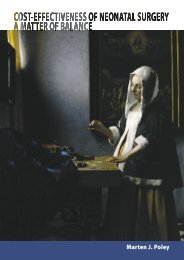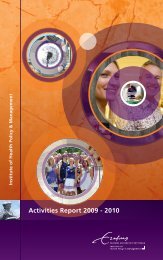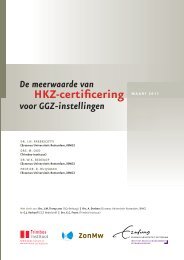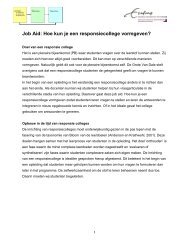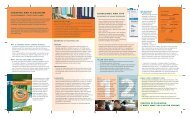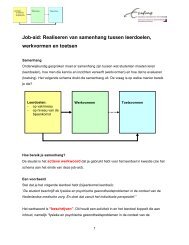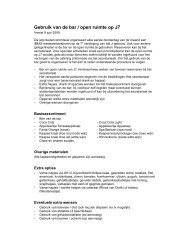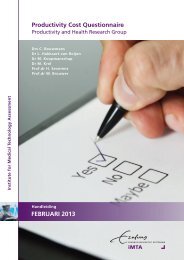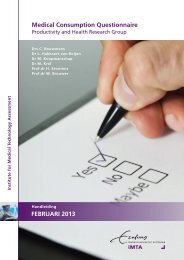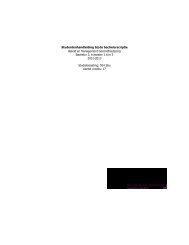Manual Short Form- Health and Labour Questionnaire (SF-HLQ)
Manual Short Form- Health and Labour Questionnaire (SF-HLQ)
Manual Short Form- Health and Labour Questionnaire (SF-HLQ)
Create successful ePaper yourself
Turn your PDF publications into a flip-book with our unique Google optimized e-Paper software.
<strong>Manual</strong><strong>Short</strong> <strong>Form</strong>- <strong>Health</strong> <strong>and</strong> <strong>Labour</strong> <strong>Questionnaire</strong>(<strong>SF</strong>-<strong>HLQ</strong>)Dr. L. Hakkaart-van RoijenDrs. C.A. M. BouwmansInstitute for Medical Technology AssessmentErasmus University RotterdamRotterdam, 2010
“All rights reserved. Nothing in this publication may be changed or reproduced without theauthors’ permission. Such permission may be obtained under the conditions stated in the UsersConditions.”1
User conditionsThis questionnaire was developed by the Institute for Medical Technology Assessment (iMTA),Erasmus University Rotterdam. The questionnaire may be used on the following conditions.Permission for usePermission to use the questionnaire <strong>and</strong> manual must be obtained in advance. To apply for suchpermission, contact the address provided at the bottom of the page, or complete <strong>and</strong> submit theenclosed registration form to the same. In principle, permission for use will be granted. There areno financial conditions attached to use of the questionnaire. However, the following conditionsmust be observed when using the questionnaire, whether such use is for commercial or scientificpurposes.Conditions for use• The copyright notice on the title page must be reproduced in cases where thequestionnaire is largely or wholly used as is. If an altered version of the questionnaire isused, this version should be stated as source material.• The source is required to be explicitly stated in all publications as follows: Hakkaart-vanRoijen L, <strong>Short</strong> <strong>Form</strong>- <strong>Health</strong> <strong>and</strong> <strong>Labour</strong> <strong>Questionnaire</strong>. Institute for Medical TechnologyAssessment, Erasmus University Rotterdam.• The liability notice printed on the title page must always be included when using themanual <strong>and</strong> questionnaire.• Changes are permitted to be made to the questionnaire without prior consent. However, itshould be very clear that these changes were made by the user.• The user shall indemnify the Institute for Medical Technology Assessment, ErasmusUniversity Rotterdam <strong>and</strong> the author of this edition against claims from third partiesarising from <strong>and</strong>/or related to the use of this edition by the user, in the event of changes<strong>and</strong> or translation, or due to errors, omissions <strong>and</strong> misinterpretations or anyconsequences of this.• To assess the use of the questionnaire <strong>and</strong> the purpose to which this is used, please fillin the registration form as fully as possible (see appendix III).• A copy of all manuscripts, articles or other publications featuring this questionnaire orcontaining results obtained with the help of this instrument shall be made available to theauthor.• For the purpose of further (validation) studies, we may request the user – in consultation– to place part of the research at the disposal of the authors, specifically the scores forthe individual questions in the questionnaire, as (if gathered) those for the questions onsex, age, diagnosis, living situation, educational attainment <strong>and</strong> work status. The datamade available on the basis of the three preceding items will be treated confidentially bythe authors.For questions <strong>and</strong> comments, please Consultation:Dr. L. Hakkaart-van RoijenInstitute for Medical Technology AssessmentErasmus University RotterdamPostbox 17383000 DR RotterdamTel: +31 10 4088555E-mail: hakkaart@bmg.eur.nl2
Table of contents1. INTRODUCTION .................................................................................................................................... 4BACKGROUND............................................................................................................................................. 4THE QUESTIONNAIRE .................................................................................................................................. 5RANDOM SAMPLE SIZE, EFFECT SIZE AND MEASUREMENT MOMENTS .......................................................... 6IMPLEMENTATION ....................................................................................................................................... 62. <strong>SF</strong>-<strong>HLQ</strong>: MODULES, SCORES AND VALUATIONS........................................................................ 7MODULE 1: ABSENCE FROM PAID WORK ..................................................................................................... 7Scoring module 1................................................................................................................................. 7Valuation module 1.............................................................................................................................. 8Costs per friction period...................................................................................................................... 9MODULE 2: PRODUCTION LOSSES NOT DUE TOT ABSENTEEISM FROM PAID WORK....................................... 9Scoring module 2.............................................................................................................................. 11Valuation module 2............................................................................................................................ 11MODULE 3: HINDRANCES IN PERFORMING PAID AND UNPAID WORK ......................................................... 12Scoring hindrance module 3 ............................................................................................................ 14Scoring substitution unpaid work (question 11) ............................................................................ 15Valuation substitution unpaid work.................................................................................................. 163. USER CONDITIONS............................................................................................................................. 174. REFERENCES ....................................................................................................................................... 18APPENDIX I QUESTIONNAIRE ........................................................................................................... 19APPENDIX II CODE BOOK <strong>SF</strong>-<strong>HLQ</strong> ................................................................................................... 27APPENDIX III REGISTRATION FORM FOR THE USE OF THE <strong>SF</strong>-<strong>HLQ</strong>................................... 333
1. IntroductionBackgroundIn economic evaluations both costs <strong>and</strong> benefits of medical interventions are examined. Theguidelines established for pharmaco-economic research stipulate that an economic evaluation beperformed from a societal perspective, i.e., that all costs <strong>and</strong> benefits be included in the analysis,regardless of by whom the costs are borne or to whom the benefits accrue (1). In healthcareeconomics, costs are distinguished into direct <strong>and</strong> indirect costs. These are subsequentlyallocated to costs incurred within <strong>and</strong> outside the healthcare system, <strong>and</strong> may be shown asfollows:Figure 1. Distribution of costs in healthcare economicsInside the healthcare systemOutside the healthcare systemDirect costs Medical costs Patient costsIndirect costs Costs during life years gained Production lossesDirect costs mainly consist of the costs of medical resources that are used, the medicalconsumption. Indirect non-medical costs are made up of costs of productivity losses caused byabsence from work due to health problems. The questionnaire discussed in this manualconcentrates on the assessment of productivity losses.Costs in economic evaluations are valued in accordance with the concept of opportunity costs.Meaning that scarcity of resources necessitates trade-offs <strong>and</strong>, consequently, utilisation ofresources for a certain target implies that an (next best) alternative for these resources must begiven up.Human resources (labour time) can be utilised for paid work as well as for unpaid work. E.g.individuals may prefer to spend less time on paid work thus resulting in extra time for leisure orvolunteer activities, or family care. Productivity losses of paid work may be caused by absencefrom work due to health problems. This absence from work may be of short or long duration. Nextto this, there are possibly productivity losses without absenteeism. E.g. someone is present atwork despite a rising migraine. This health condition may cause a situation in which the amount ofwork that is realized after a working day is lower than usual. In these cases efficiency lossesoccur.4
The <strong>Short</strong> <strong>Form</strong> <strong>Health</strong> <strong>and</strong> <strong>Labour</strong> <strong>Questionnaire</strong> (<strong>SF</strong>-<strong>HLQ</strong>) is a generic <strong>and</strong> validatedmeasurement instrument to collect data of productivity losses related to health problems inindividuals with paid or unpaid work.The next paragraph discusses general features of the questionnaire <strong>and</strong> presents some remarksfor the utilization of the questionnaire. In chapter 2 a comprehensive description is given of thequestions of the <strong>SF</strong>-<strong>HLQ</strong> <strong>and</strong> methods for the registration <strong>and</strong> valuation of data. The <strong>SF</strong>-<strong>HLQ</strong> <strong>and</strong>the corresponding codebook are supplemented in appendices I <strong>and</strong> II respectively. In chapter 3the user conditions are reported <strong>and</strong> a user registration form is attached in appendix III.The <strong>Questionnaire</strong>The <strong>SF</strong>-<strong>HLQ</strong> is suitable for evaluations in various diseases (episodic <strong>and</strong> chronic conditions,physical <strong>and</strong> mental disorders) <strong>and</strong> is completed by the patients themselves. The st<strong>and</strong>ardversion of the <strong>SF</strong>-<strong>HLQ</strong> inquires about productivity losses that are caused by health problems ingeneral. Depending on the disorder questions may be aimed at productivity losses caused by aspecific disorder. This is only possible in situations that respondents are expected to be able tomake a distinction between the target disorder <strong>and</strong> the remaining health problems <strong>and</strong> thedistinction is essential within the study design. Fundamentally, if patients are r<strong>and</strong>omised there isno need of this distinction.The <strong>SF</strong>-<strong>HLQ</strong> consists of three modules (absenteeism from paid work, production losses withoutabsenteeism from paid work <strong>and</strong> hindrance in the performance of paid <strong>and</strong> unpaid work).Possibly one of these modules does not apply in case of a specific disorder, <strong>and</strong> the module cansimply be left out. For example, supposing that a study aims to evaluate the treatment of anacute appendicitis. It is implausible that efficiency losses are an important part of the indirectcosts. In this case the module of productivity losses without absenteeism can be left out. This iscontrary to a study in which the treatment in patients with migraine is evaluated. In spite of theinconvenience caused by this condition patients may tend to go to work, but productivity may bedistracted.At the end of the questionnaire a section with general questions is added. Co-morbidities mayplay an important role in specific disorders, e.g. chronic or emotional health problems, for thevolume of productivity losses. In these cases we recommend to collect data on co morbidity. A listof 27 chronic disorders is included as is used by the Dutch Central Office of Statistics in thegeneral section. Additionally, in this section questions regarding background variables (includingsex, date of birth) are included. This section is required to be filled in only once, even if themeasurements are performed more than once.5
R<strong>and</strong>om sample size, effect size <strong>and</strong> measurement momentsIn an economic evaluation, the minimum group size <strong>and</strong> number of measurement momentsdepends on a variety of factors. The number of respondents in a r<strong>and</strong>om sample depends on theexpected differences in healthcare consumption <strong>and</strong> production losses between the experimentalgroup <strong>and</strong> the control group. Furthermore, next to costs, other effect measurements are includedin an analysis of this kind (such as clinical effects, quality of life) which may be relevant to thenumber of respondents to be included. The recall period in the <strong>SF</strong>-<strong>HLQ</strong> is one month. However, ifthe respondents were absent for the complete month because of health-related problems, theyare asked when this period of absence had started. Hence, data on long-term absence iscollected.When calculating the costs, it was assumed that the period of time during which themeasurement was carried out, was representative for the period between two measurementmoments. The optimum length of time between two measurement moments, number ofmeasurements <strong>and</strong> number of respondents required depends on the difference in costs (<strong>and</strong>other effect measurements), the expected course of the disease <strong>and</strong> the treatment. Therefore itmay be desirable to adjust the recall-period. However, longer recall-periods may induce chancesof errors.ImplementationThe <strong>SF</strong>-<strong>HLQ</strong> can be conducted in writing <strong>and</strong> orally. The following options are available:• The respondent completes the <strong>SF</strong>-<strong>HLQ</strong> independently; the questionnaire is sent by e-mail ormail, or is available through the website, together with written instructions on how to completethis.• The respondent completes the <strong>SF</strong>-<strong>HLQ</strong> independently, after receiving oral instructions, bytelephone or otherwise, on how to do so.• Lastly, the <strong>SF</strong>-<strong>HLQ</strong> may be conducted by an interviewer, either by telephone or during a visitto the respondent’s home.6
2. <strong>SF</strong>-<strong>HLQ</strong>: modules, scores <strong>and</strong> valuationsThe <strong>SF</strong>-<strong>HLQ</strong> consists of three modules (absenteeism from paid work, production losses withoutabsenteeism from paid work <strong>and</strong> hindrance in the performance of paid <strong>and</strong> unpaid work). Thequestionnaire uses to the general term ‘health problems’. If preferable the questionnaire can alsobe made more disease-specific by distinguishing between the ‘target disorder’ <strong>and</strong> ‘other healthproblems’. In each case the questions pertain to the past month, except for Part 2 of questiontwo, which asks about long absence from work. A 'recall' period of one month was selected, asstudies show that the accuracy of the information is dependent on the period to which thequestions pertain (2).The three modules of the <strong>SF</strong>-<strong>HLQ</strong> are discussed in the following paragraphs.Module 1: Absence from paid workQuestions 1 <strong>and</strong> 2 of Part I of the questionnaire jointly make up module 1 of the <strong>SF</strong>-<strong>HLQ</strong>The respondent is first asked whether or not he or she holds a paid job. A respondent with a paidjob is asked about the number of days <strong>and</strong> hours he or she performs paid work. Next, they areasked about the number of work days lost due to health problems. If this number should exceedthe period of one month, respondents are asked to state when they reported sick.Scoring module 1To calculate the indirect costs, the days of absenteeism are measured <strong>and</strong> valued as follows. Thedays of absenteeism over the past month are determined per respondent. If this period is shorterthan the past month, the number of days of absenteeism for the past month can be based on theanswer to the first part of question 2. Hence, the minimum number of days is 0, <strong>and</strong> the maximum31. Based on the response to question 1, the number of hours worked per day can bedetermined, adjusted if necessary for part-time work in connection with the valuation ofproduction losses. If one month is indeed representative for the absenteeism rate throughout theyear, the number of days of absenteeism per year is subsequently calculated by multiplying theresult by 12. If the respondent reports having missed more than a month of work, the number ofdays lost is counted from the day the respondent reported sick. Obviously, when calculatingproduction losses, the number of hours worked per working week <strong>and</strong> the number of work dayswill again be taken into account.7
Valuation module 1There are two methods to value the measured absenteeism from paid work days. First,information on net income which is derived by question 8 of the <strong>SF</strong>-<strong>HLQ</strong> can be used to value thedays of absence from work. The validity of these data should be checked. Outliers can bechecked on the basis of the questions about the respondent’s occupation (question 1).Alternatively, the valuation may also be performed on the basis of the average production valueper worker for the Netherl<strong>and</strong>s. Desirably, production values by age <strong>and</strong> sex can be applied if(see table 2). A full work day is eight hours. The preferred method depends on the aim of thestudy <strong>and</strong> the study design.For the determination of the value of lost production due to health problems, different approachesmay be chosen. Two important alternative starting points are available (3). We recommendapplying the method known as the ‘friction cost’ method for the valuation of production losses, asthis is based on the actual production losses viewed from a societal perspective. This method ismore in line with the methodology applied in economic evaluation (4). The method is based onthe idea that everyone in the production process is replaceable. The indirect costs are thuslimited to the production losses suffered in the period until the vacancy has been filled. The lengthof this so-called ‘friction period’ is dependent on the pace at which the vacancy is able to be filled,which in turn depends on, for example, the unemployment rate <strong>and</strong> the degree of mobility in thelabor market. The length of time that is necessary to fill the vacancy can be taken as an indicationof the friction period. According to the ‘human capital’ method the total production value to begenerated by a person potentially last during a lifetime (until retirement). Consequently, thehuman capital approach generates potential rather than actual productivity costs, leading tounrealistically estimates of high productivity costs.(5)For example, in case of an employee who is off work for, say, six months as a consequence of ahernia the indirect costs according to the friction cost method will be limited to any lost productiontime during the friction period. However, according to the human capital method the indirect costsare equal to this patient’s production value throughout this entire period (e.g. six months) whilethis approach ignores the possibility of replacement of long-term absenteeism.The difference in volume of indirect costs resulting from application of either the friction costs orhuman capital method will increase the longer the period of absenteeism.The second part of question 2 was added to obtain additional information about the length of theperiod of absenteeism if this should extend beyond the period of one month. If the days ofabsenteeism exceed the length of the friction period, production losses will remain confined to thefriction period. On the basis of data on the estimated vacancy period of 2008, the friction periodwas calculated at 23 weeks, or 160 days. (6)8
Costs per friction periodTable 2 shows the average costs per hour for 2008 en 2009 in the Netherl<strong>and</strong>s, by age <strong>and</strong> sex.These costs have been calculated based on the average added net value per worker. These areaverages for the entire group of employed persons in the relevant class, given the existingindividual differences in income, labor productivity <strong>and</strong> number of hours worked. Studies haveshown that a decrease in the amount of time worked (e.g. due to absenteeism) yields a less thanproportional decrease in productivity (7, 8). The figures presented in table 2 are corrected for thiselasticity of labour time. For periods of absenteeism (measured in calendar days, includingweekends <strong>and</strong> holidays) that are shorter than the friction period, the productivity costs arecalculated in the following manner. Take, for example, the case of a 37 year-old man who was offwork for two weeks (14 days). A year is held to be made up of an average of 1540 working hours.The 2009 productivity costs are thus: 2/52 * 1540 hours * € 34.03 = € 2015.62Please refer to Koopmanschap <strong>and</strong> Rutten for further specifics <strong>and</strong> information on calculatingfriction costs (3).Table 2. Productivity costs per hour per paid working individual for 2008/2009 (in Euros)2008 2009*Age Total Men Women Total Men Women15-19 years 9.02 9.39 8.52 9.27 9.65 8.7620-24 years 17.03 17.27 16.72 17.51 17.75 17.1825-29 years 23.28 23.53 22.98 23.93 24.19 23.6230 tot 35 years 28.02 28.84 26.79 28.80 29.65 27.5435 tot 40 years 31.37 33.10 28.45 32.25 34.03 29.2540 tot 45 years 33.00 35.67 28.27 33.92 36.67 29.0645 tot 50 years 33.92 37.27 28.12 34.87 38.32 28.9150 tot 55 years 34.64 37.99 28.45 35.61 39.06 29.2555 tot 60 years 35.37 38.31 28.69 36.37 39.38 29.5060 tot 65 years 35.42 38.07 27.88 36.41 39.13 28.6765 tot 75 years 27.32 28.45 22.25 28.08 29.25 22.87>=75 years 20.78 21.46 18.21 21.36 22.06 18.72Mean to gender 29.20 31.61 25.24 30.02 32.49 25.94Overall mean 29.20 30.02Based on 2008 <strong>and</strong> concerted to 2009 on the basis of the general price index figure.Module 2: Production losses not due tot absenteeism from paid workThe questions 3, 4, 5 <strong>and</strong> 7 of the <strong>SF</strong>-<strong>HLQ</strong> are related to module 2 (see also appendix I).9
Individuals with health problems are sometimes forced to miss work because of these problems.However, it is often the case that they go to work, but perform less well because of their healthproblems. Research has shown that some 7% of all employees reports experiencing hindrance atwork as a result of health problems. This illustrates just how considerable this cost component is,although consensus has not yet been reached on the quantification hereof. This does not mean,however, that describing <strong>and</strong>, where possible, quantifying production losses should beconsidered unimportant.Question 3 selects between persons who are hindered by health problems in performing paidwork, <strong>and</strong> those who are not. For those reporting that they are not hindered by health problems, itfollows that there are no production losses not due to absenteeism as a result of health problems.The remaining questions in module 2 may be skipped. Those reporting adverse effects on theirjob performance due to health problems are requested to complete questions 4 through 7.Question 6 is a descriptive instrument by which the hindrance can be evaluated (see module 3).There are two methods by which to calculate production losses not caused by absenteeism.The <strong>HLQ</strong> method uses direct estimates of production losses caused by time ‘lost’ due to healthproblems on work days (see figure 3). In question 7 the respondent is asked to estimate thenumber of hours he or she would have to work in order to compensate for the time ‘lost’ due tohealth problems on work days.Figure 3 Question to determine production losses not due to absenteeism based on the "<strong>HLQ</strong>" method(7) If you had to catch up on all the work you were unable to perform over the past two weeksbecause of health problems, how many hours work would you be forced to make up?............... hours(The days on which you failed to work at all because you reported ill do not count.)Question 4 <strong>and</strong> 5 together constitute an alternative method proposed by Osterhaus et al (9).Here, the production losses are determined on the basis of two questions. In question 4,individuals are asked about the number of days of hindrance due to health problems. In question5, they are asked about their estimated efficiency on these days.10
Figure 4 Questions designed to determine production losses not due to absenteeism based on the‘Osterhaus’ method(4) On how many days during the past month did you perform paid work, although you werebothered by health problems?....................... days (Please do not count the days on which you did not work at all becauseyou reported sick.)(5) Please rate how well you performed on the days you went to work even though you weresuffering from health problems.((1 indicates a much worse performance than usual <strong>and</strong> 10 that your work was not affected.)1 2 3 4 5 6 7 8 9 0 verypoorperformedas usualScoring module 2The <strong>SF</strong>-<strong>HLQ</strong> contains two methods for calculating production losses that are not the result ofabsenteeism. The lack of a gold st<strong>and</strong>ard renders it difficult to validate these measurementmethods.The number of hours of efficiency loss is calculated using the <strong>HLQ</strong> method on the basis of thenumber of hours stated in the answer to question 7.According to the method proposed by Osterhaus, the number of days of hindrance leading toproduction losses is multiplied by one minus the efficiency for these days. A respondent may, forexample, indicate that he or she was bothered by health problems on three work days, <strong>and</strong> ratetheir efficiency at eight. The production loss is in that case 3*(1-0.8) * 8= 0.6 work day, or 4.8hours based on an eight-hour workday. In cases of respondents indicating to work less or morehours a day this will be accounted for in the calculation.Valuation module 2The answer to question 7 is used to make a quantitative estimate according to the <strong>HLQ</strong> method(in euros) of the production losses without absenteeism (‘presenteeism’). The hours are valued atthe average income per hour on the basis of the responses to question 8 on income, combinedwith the results of question 1 on the number of work days <strong>and</strong> hours per week. Production losses11
without absenteeism may also be valued on the basis of the average production value by age <strong>and</strong>sex, as stated in table 2.The <strong>HLQ</strong> method for determining production losses without absenteeism may yield anunderestimation of the actual costs of production losses. Question 7 explicitly asks to estimatethe number of hours the respondent requiring to catch up on the production losses.Consequently, this may ignore the possibility that production losses can not be compensatedwithin normal work hours. Additionally, costs incurred because colleagues or temporary workersare required to take over from the individual in question might not be included. (10) However,whether or not it is possible to make up for lost hours of work strongly depends on work featuressuch as type of work, type of organization, degree of autonomy, etc. On the other h<strong>and</strong>,estimating productivity losses according to the Osterhaus method may generate anoverestimation since respondents may judge their efficiency by the potential amount of work theycould have done rather than by the normal amount of work they usually do.Question 9 is a general question on the basis of which the population can be divided into sixdifferent categories.Figure 5 Question to classify persons without a paid job(9). Which of the following situations applies best to your case? I have paid work I run the household (<strong>and</strong>, if applicable, care for the children) I am retired or have taken early retirement. I am still at school I am (partially) unfit for paid work because of health problems<strong>and</strong> have been assessed as am ........................ % incapacitated for work I do not have paid work for other reasons(E.g. involuntary unemployment or volunteer work.)Module 3: Hindrances in performing paid <strong>and</strong> unpaid workIn this module, a distinction is made between hindrances in performing paid or unpaid work. Inconclusion, it is examined to what extent any hindrance in performing unpaid work has led to thesubstitution of unpaid work in the household.Question 3, 6 <strong>and</strong> 10 of the <strong>SF</strong>-<strong>HLQ</strong> relate to the hindrance experienced in performing paid <strong>and</strong>unpaid work. As described earlier, the answers to question 3 are used to select betweenrespondents who are hindered by, <strong>and</strong> those not hindered by health problems. The answers may12
also be used to determine the hindrance score for paid work. The range for this score is from zero toa maximum of 2.Figure 6 Question to determine the hindrance score in the case of paid work(3) Was your job performance adversely affected by health problems during the past month? No, not at all (go to question 8)) Yes, slightly Yes, very muchQuestion 6 is a descriptive instrument comprised of 7 items designed to evaluate the specificproblems affecting production. These 7 items relate to the effect of health problems onconcentration, work pace, the need to be alone, making decisions, postponing <strong>and</strong> transferringwork to others. The respondent can choose from four possible answers: (almost) never,sometimes, often <strong>and</strong> (nearly) always.Figure 7 The seven items by which to evaluate production(6) Below are a number of statements that may apply to people in the paid work force with healthproblems. Please indicate how often each statement was applicable to you during the 2 weeks.I went to work, but as a result of health problems…….I had concentration problemsI had to work at a slower paceI had to work in seclusionI had more difficulty making decisionsI had to postpone workOthers had to take over my workalmost some- often nearlynever times alwaysI had other problems, namely:............................................................................................................................................Question 10 relates to the hindrances experienced in performing unpaid work. Respondents areasked to indicate whether they have carried out any of the four unpaid activities listed in thisquestion. The response ‘performed this activity’ is followed by two possible choices, namely washindered in doing so by health problems, or was not. The response ‘did not perform this activity’ was13
followed by the question of whether the inability to perform the task was due to health problems ofwhether there were other reasons.Figure 8Hindrance in performing unpaid work(10) Did you undertake any of the following activities during the past two weeks, <strong>and</strong> didhealth problems play any part in this?a. Household work (e.g. preparing food, cleaning the house, doing the wash.)Performed this activity without being bothered by health problemsPerformed this activity, although bothered by health problemsDid not perform this activity because of health problemsDid not perform this activity for reasons other than health problemsb. Going shopping (e.g. daily groceries, shopping, visit to bank or post office.)Performed this activity without being bothered by health problemsPerformed this activity, although bothered by health problemsDid not perform this activity because of health problemsDid not perform this activity for reasons other than health problemsc. Odd jobs (e.g. maintenance work on house, garden, bicycles <strong>and</strong> vehicles.)Performed this activity without being bothered by health problemsPerformed this activity, although bothered by health problemsDid not perform this activity because of health problemsDid not perform this activity for reasons other than health problemsd. Specific activities for or with the children sharing your household (e.g. personal care,play, taking the children to school, helping with their homework.)Performed this activity without being bothered by health problemsPerformed this activity, although bothered by health problemsDid not perform this activity because of health problemsDid not perform this activity for reasons other than health problemsNot applicableScoring hindrance module 314
Question 3 is used as an indicator for hindrance in performing paid work due to health problems,the hindrance score. The hindrance score for paid work is arrived at by weighting the responsesas follows: ‘no, not at all = 0, yes, slightly = 1 <strong>and</strong> ‘yes, very much’ = 2. The score range is 0 to 2.The distribution of the responses per item in question 6 offer a description of the specificproblems encountered in performing paid work. In the unweighted situation, the weights for thecategories are as follows: never=1, sometimes=2, often=3, <strong>and</strong> always-4. The efficiency score isderived by adding up the unweighted items of the responses: the minimum score is 6, themaximum is 24.The scores for the items on hindrance in performing unpaid work are: Performed activity,hindered = 1 ; Performed activity, no hindrance, = 0 ; Did not perform activity, due to healthproblems = 2 ; Did not perform, for other reasons = 0.The total hindrance score for unpaid work is derived by adding up the item scores. This hindrancescore is a measure of the hindrance experienced as a result of health problems during theperformance of unpaid work. The minimum score per item is zero <strong>and</strong> the maximum is 2. Thetotal score is arrived at when the scores of all 4 items are added together. The total score rangesfrom 0 to 8.Question 11 is concerned with the question of whether the household <strong>and</strong> other tasks normallycarried out by the respondent, were postponed or carried out instead by other members of thehousehold, family or friends <strong>and</strong>/or paid help. These data can provide insight into the shift inunpaid work in the household <strong>and</strong>/or substitution of tasks by the formal healthcare organization.Figure 9Question on substitution of unpaid household work(11) Was it necessary for others to take over <strong>and</strong> perform your usual household tasks duringthe past month in connection with health problems?NoYes, namely (more than one answer is possible):• family members for..................... hours• other persons receiving no pay for..................... hours• home care for..................... hours• other paid care for..................... hoursScoring substitution unpaid work (question 11)The answers to question 11 are used to calculate the number of hours of unpaid work that maypossibly have to be taken over by other unpaid <strong>and</strong>/or paid help. To this end, the number of hoursof unpaid work performed by ‘family members (item 1) <strong>and</strong> ‘others’ (item 2) are categorized as15
‘unpaid help’ (what is known as ‘informal’ help). The hours of unpaid work that are taken over byprofessional home care services (item 3), ‘family care services (item 4) <strong>and</strong>/or other professional,paid help (formal help). The responses to this question can be considered an indicator of theseverity of the disorder or treatment <strong>and</strong> the effect on the respondent’s functioning in thehousehold.Valuation substitution unpaid workDifferent methods exist to valuate unpaid work. The method according to the replacement valuetheory is based on the idea that, by performing the work personally, costs are saved that wouldotherwise have been incurred to hire an individual who offers those services on the market. This isthe preferred method, as in this case, the (lost) production is weighted equally, regardless of whetheran individual holds a paid job or not. To value production losses in unpaid work, we use as anindication the average gross hourly wage earned by a domestic worker. The ‘opportunity cost’approach values unpaid work hours by trading these off against the net income earned by anindividual performing paid work. A significant disadvantage to this method is that this market wage isable to be determined only for those in a paid job..16
3. User conditionsThis questionnaire was developed by the Institute for Medical Technology Assessment (iMTA),Erasmus University Rotterdam. The questionnaire may be used on the following conditions.Permission for usePermission to use the questionnaire <strong>and</strong> manual must be obtained in advance. To apply for suchpermission, contact the address provided at the bottom of the page, or complete <strong>and</strong> submit theenclosed registration form to the same. In principle, permission for use will be granted. There areno financial conditions attached to use of the questionnaire. However, the following conditionsmust be observed when using the questionnaire, whether such use is for commercial or scientificpurposes.Conditions for use• The copyright notice on the title page must be reproduced in cases where thequestionnaire is largely or wholly used as is. If an altered version of the questionnaire isused, this version should be stated as source material.• The source is required to be explicitly stated in all publications as follows: Hakkaart-vanRoijen L, <strong>Short</strong> <strong>Form</strong>- <strong>Health</strong> <strong>and</strong> <strong>Labour</strong> <strong>Questionnaire</strong>. Institute for Medical TechnologyAssessment, Erasmus University Rotterdam.• The liability notice printed on the title page must always be included when using themanual <strong>and</strong> questionnaire.• Changes are permitted to be made to the questionnaire without prior consent. However, itshould be very clear that these changes were made by the user.• The user shall indemnify the Institute for Medical Technology Assessment, ErasmusUniversity Rotterdam <strong>and</strong> the author of this edition against claims from third partiesarising from <strong>and</strong>/or related to the use of this edition by the user, in the event of changes<strong>and</strong> or translation, or due to errors, omissions <strong>and</strong> misinterpretations or anyconsequences of this.• To assess the use of the questionnaire <strong>and</strong> the purpose to which this is used, please fillin the registration form as fully as possible (see appendix III).• A copy of all manuscripts, articles or other publications featuring this questionnaire orcontaining results obtained with the help of this instrument shall be made available to theauthor.• For the purpose of further (validation) studies, we may request the user – in consultation– to place part of the research at the disposal of the authors, specifically the scores forthe individual questions in the questionnaire, as (if gathered) those for the questions onsex, age, diagnosis, living situation, educational attainment <strong>and</strong> work status. The datamade available on the basis of the three preceding items will be treated confidentially bythe authors.For questions <strong>and</strong> comments, please Consultation:Dr. L. Hakkaart-van RoijenInstitute for Medical Technology AssessmentErasmus University RotterdamPostbox 17383000 DR RotterdamTel: +31 10 4088555E-mail: hakkaart@bmg.eur.nl17
4. References1. Nederl<strong>and</strong>se richtlijnen voor farmaco economisch onderzoek.(Dutch guidelines forpharmaco economic research). Amstelveen: Ziekenfondsraad; 1999.2. Severens J, Mulder J, Laheij R, AL AV. Precision <strong>and</strong> accuracy in measuring absencefrom work as a basis for calculating productivity costs in The Netherl<strong>and</strong>s. Soc Sci Med.2000;51(2):243-9.3. Koopmanschap M, Rutten F. A practical guide for calculating indirect costs of disease.Pharmacoeconomics. 1996;10 (5):460-6.4. Tan SS, Bouwmans C, Hakkaart- van Roijen L. H<strong>and</strong>leiding voor kostenonderzoek.Methoden en referentieprijzen voor economische evaluaties. [<strong>Manual</strong> for cost research, methods<strong>and</strong> reference prices for economic evaluations in health care]. Diemen: <strong>Health</strong> Insurance Board2010 (in press)5. Drummond M. Cost of illness studies: a major headache? Pharmacoeconomics.1992;2:1-4.6. Vacatures in Nederl<strong>and</strong> 2008, De vacaturemarkt en personeelwerving in beeldAmsterdam: CWI. Oktober 2008.7. Onzekerheid over werktijdvermindering op de middenlange termijn. Den Haag: CentraalPlan Bureau (CBP); 1987.8. Koning J, Tuyl F. De relatie tussen arbeidstijd, productie en werk. Rotterdam Nederl<strong>and</strong>sEconomisch Instituut; 1984.9. Osterhaus J, Gutterman D, Plachetka J. <strong>Health</strong> care resource <strong>and</strong> labor costs of migraineheadache in the US. Pharmacoeconomics. 1992;2(1):67-76.10. Brouwer W, Koopmanschap M, Rutten F. Productivity losses without absence:measurement validation <strong>and</strong> empirical evidence. <strong>Health</strong> Policy. 1999;48(1):13-27.18
Appendix I: <strong>Questionnaire</strong><strong>Short</strong> <strong>Form</strong>- <strong>Health</strong> <strong>and</strong> <strong>Labour</strong><strong>Questionnaire</strong><strong>SF</strong>-<strong>HLQ</strong>19
This questionnaire concerns the consequences of health problems for employment in a paid job<strong>and</strong> for unpaid work (e.g. household chores). These questions pertain to the period covering thepast month. <strong>Health</strong> problems refer both to your physical <strong>and</strong> emotional problems.Date: ... - .. - 20..1. Do you currently hold a paid job?No, (go to question 9)Yes;How many hours does your contract specify? ………….…… hours per weekOver how many days are these hours distributed? ………….…… daysWhat is your occupation? ...................................................................................2. Did health problems oblige you to be off work at any time in the past month?NoYes, I missed ………….…… days of work(One week has a maximum of 5 days of work)Were you off work for a period longer than the past month because of health problems?NoYes, I reported ill on............... ............... ......................... (go on to question 8)People with health problems sometimes have to miss work because of these problems.Another possibility is that a person goes to work, but is unable to perform as well as he shouldbecause of health problems. Questions 18 through 22 focus on these aspects.3. Was your job performance adversely affected by health problems during the past month?No, not at all (go to question 8)Yes, slightlyYes, very much4. On how many days during the past month did you perform paid work, although you werebothered by health problems?....................... days (Please do not count the days on which you did not work at all becauseyou called in sick.)20
5. Please rate how well you performed on the days you went to work even though you werebotheredby health problems.(1 indicates a much worse performance than usual <strong>and</strong> 10 that your work was not affected.)1 2 3 4 5 6 7 8 9 10muchworseperformedas usual6. Below are a number of statements that may apply to people in the paid work force withhealth problems. Please indicate how often each statement was applicable to you during thepast month.I went to work, but as a result of health problems…….I had concentration problemsI had to work at a slower pacealmost some- often nearlynever times alwaysI had to work in seclusionI had more difficulty making decisionsI had to postpone workOthers had to take over my workI had different problems, namely:.........................................................................................7. If you had to catch up on all the work you were unable to perform over the past month becauseof health problems, how many hours of work would you be forced to make up?.................... hours(The days on which you failed to work at all because you reported ill do not count).8. What is your own net income from paid work ?(This refers to the amount you actually receive. We are interested only in your income, i.e.exclusive of, if present, your partner’s income)€.............per week€.............per 4 weeks€.............per month€.............per yearDon’t know/don’t wish to reveal21
9. Which of the following situations applies to you? If more than one applies, indicate thesituation that applies most to your case.I have paid workI run the household (<strong>and</strong>, if applicable, care for the children)I am retired or have taken early retirement.I am still at schoolI am (partially) unfit for paid work because of health problems<strong>and</strong> have been assessed as being ........................ % incapacitated for workI do not have paid work for other reasons(E.g. involuntary unemployment or volunteer work.)10. Did you undertake any of the following activities during the past two weeks, <strong>and</strong> did healthproblems play any part in this?a. Household work (e.g. preparing food, cleaning the house, doing the wash.)Performed this activity without being bothered by health problemsPerformed this activity, although bothered by health problemsDid not perform this activity because of health problemsDid not perform this activity for reasons other than health problemsb. Going shopping (e.g. daily groceries, shopping, visit to bank or post office.)Performed this activity without being bothered by health problemsPerformed this activity, although bothered by health problemsDid not perform this activity because of health problemsDid not perform this activity for reasons other than health problemsc. Odd jobs (e.g. maintenance work on house, garden, bicycles <strong>and</strong> vehicles.)Performed this activity without being bothered by health problemsPerformed this activity, although bothered by health problemsDid not perform this activity because of health problemsDid not perform this activity for reasons other than health problemsd. Specific activities for or with the children sharing your household (e.g. personal care, play,taking the children to school, helping with their homework.)Performed this activity without being bothered by health problemsPerformed this activity, although bothered by health problemsDid not perform this activity because of health problemsDid not perform this activity for reasons other than health problemsNot applicable22
11. Did other people take over <strong>and</strong> perform your usual household tasks in the past month inconnection with health problems?NoYes, namely (more than one answer is possible):• family members for..................... hours• other persons receiving no pay for..................... hours• home care for..................... hours• other paid care for..................... hours…………………………………………………………………………………………………………….23
General questions1. Sex:malefemaleDate of birth: ............_............_.........................What is the highest level of education that you have completed?Primary school (lower school, special education)Lower vocational education (e.g. LTS, LHNO, LEAO, domestic training school)Lower general secondary education (e.g. VMBO, ULO, MULO, MAVO)Secondary vocational education (e.g. MTS, MEAO, MHNO)Senior general secondary education (e.g. HBS, MMS, HAVO, VWO, gymnasium)Higher professional education (e.g. HTS, HEAO, HHNO)UniversityOther, namely:....................................................................................................................................................................................................................2. What is your current civil status?SingleMarried/long-term cohabitationDivorcedWidow(er)3. Below is a list of chronic conditions <strong>and</strong> disorders. Please indicate the conditions you have orhadduring the past year?Asthma, chronic bronchitis or COPDInfection of the nasal cavity, frontal sinus cavity or CCCCCSevere heart condition or myocardial infarction24
High blood pressureStroke, or the consequences of a strokeGastric or duodenal ulcerSevere intestinal disorders lasting for longer than 3 monthsGall bladder stones or gall bladder infectionLiver disease or liver cirrhosisKidney stonesSevere kidney diseaseChronic bladder infectionProlapseDiabetesThyroid diseasePersistent (longer than 3 months) back problems, or herniated discJoint degradation (arthritis) of the knees, hips or h<strong>and</strong>sJoint inflammation (rheumatism) of the h<strong>and</strong>s <strong>and</strong>/or feetOther chronic rheumatism, lasting longer than 3 monthsEpilepsyOther neurological diseases, such as Parkinson’s diseaseMultiple sclerosisDizziness <strong>and</strong> fallingMigraineMalignancy, cancer25
Overstressed, depression, severe nervousnessChronic skin disease or eczemaInjury due to an accident in <strong>and</strong> around the house, during sports, at school, work or intrafficWe are grateful to you for taking the time <strong>and</strong> making the effort to complete this questionnaire.If you have any comments, remarks or suggestions, please let us know.......................................................................................................................................................................................................................................................................................................…………………………………………………………………………………………………………….26
Appendix II Code book <strong>SF</strong>-<strong>HLQ</strong>Variable name Description ValuesINVULDATDate of completion<strong>HLQ</strong>1A Do you currently hold a paid job? 1 = no2 =yes999 = missing<strong>HLQ</strong>1B1 Hours specified in contract Number greater than 0-1 = no paid work999 = missing<strong>HLQ</strong>1B2 Number of days per week Number greater than 0-1 = no paid work999 = missing<strong>HLQ</strong>1C Description occupation Text<strong>HLQ</strong>2A Missed work in past month? 1 =no2 =yes-1 = no paid work999 = missing<strong>HLQ</strong>2B Number of days off work? Number greater than 00 = no missed work-1 = no paid work999 = missing<strong>HLQ</strong>2C Off work for longer than a month? 1 = no2 = yes-1 = no paid work999 = missing<strong>HLQ</strong>2DDate reported ill<strong>HLQ</strong>3A Hindrance in performance paid work? 1 = no, not at all2 = yes, slightly3 = yes, very much-1 = no paid work-2 = off work for longer than 1month (<strong>HLQ</strong>2C=2)999 = missing<strong>HLQ</strong>4A<strong>HLQ</strong>5APerformed how many days of paid workwhile bothered by health problems?Rating of how well (efficiently) youperformed on the days you went to workeven though bothered by healthproblems.Number greater or equal to 0<strong>and</strong> smaller or equal to 31-1 = no paid work-2 = off work for longer than 1month (<strong>HLQ</strong>2C =2 )-3 = paid work, no hindrance(<strong>HLQ</strong>3A = 1)Whole number between 1 <strong>and</strong> 10-1 = no paid work-2 = off work longer than 1 month(<strong>HLQ</strong>2C = 2)27
-3 = have paid work, nohindrance (<strong>HLQ</strong>3A = 1)<strong>HLQ</strong>6A ..had concentration problems 1 = almost never2 = sometimes3 = often4 = nearly always-1 = no paid work-2 = off work longer than 1 month(<strong>HLQ</strong>2C = 2)-3 = have paid work, nohindrance (<strong>HLQ</strong>3A = 1)<strong>HLQ</strong>6B .. worked at a slower pace 1 = almost never2 = sometimes3 = often4 = nearly always-1 = no paid work-2 = off work longer than 1 month(<strong>HLQ</strong>2C = 2)-3 = have paid work, nohindrance (<strong>HLQ</strong>3A = 1)<strong>HLQ</strong>6C .. in seclusion 1 = almost never2 = sometimes3 = often4 = nearly always-1 = no paid work-2 = off work longer than 1 month(<strong>HLQ</strong>2C = 2)-3 = have paid work, nohindrance (<strong>HLQ</strong>3A = 1)<strong>HLQ</strong>6D .. problems with making decisions 1 = almost never2 = sometimes3 = often4 = nearly always-1 = no paid work-2 = off work longer than 1 month(<strong>HLQ</strong>2C = 2)-3 = have paid work, nohindrance (<strong>HLQ</strong>3A = 1)<strong>HLQ</strong>6E .. postponed work 1 = almost never2 = sometimes3 = often4 = nearly always-1 = no paid work-2 = off work longer than 1 month(<strong>HLQ</strong>2C = 2)-3 = have paid work, nohindrance (<strong>HLQ</strong>3A = 1)<strong>HLQ</strong>6F .. had work performed by someone else 1 = almost never2 = sometimes3 = often4 = nearly always28
<strong>HLQ</strong>6G1 Description other problems Text-1 = no paid work-2 = off work longer than 1 month(<strong>HLQ</strong>2C = 2)-3 = have paid work, nohindrance (<strong>HLQ</strong>3A = 1)<strong>HLQ</strong>6G2 .. problem described 1 = almost never2 = sometimes3 = often4 = nearly always-1 = no paid work-2 = off work longer than 1 month(<strong>HLQ</strong>2C = 2)-3 = have paid work, nohindrance (<strong>HLQ</strong>3A = 1)<strong>HLQ</strong>7ANumber of hours needed to work to catchup?Number greater than 0-1 = no paid work-2 = off work longer than 1 month<strong>HLQ</strong>2C=2)-3 = have paid work, nohindrance (<strong>HLQ</strong>3A = 1)<strong>HLQ</strong>8A Personal net income from paid work Number greater than 0 (in euros)-2 = won't say-1 = no paid work999 = missing<strong>HLQ</strong>8B Frequency 1 = per week2 = per 4 weeks3 = per month4 = per year-2 = won’t say-1 = no paid work999 = missing<strong>HLQ</strong>9A Situations 1. paid work2. run the household3. retired / early retirement.4. still at school5. (partially) unfit for paid workbecause of health problems6. no paid work for other reasons999 = missing<strong>HLQ</strong>9B % incapacity for work Number greater than 0-1 = not incapacitated for work999 = missing<strong>HLQ</strong>10A Household work 1. Performed this activity withoutbeing bothered by healthproblems2. Performed this activity,although bothered by healthproblems3. Did not perform this activity29
ecause of health problems4. Did not perform this activity forother reasons999= missing<strong>HLQ</strong>10B Groceries 1. Performed this activity withoutbeing bothered by healthproblems2. Performed this activity,although bothered by healthproblems3. Did not perform this activitybecause of health problems4. Did not perform this activity forother reasons999 = missing<strong>HLQ</strong>10C Odd jobs 1. Performed this activity withoutbeing bothered by healthproblems2. Performed this activity,although bothered by healthproblems3. Did not perform this activitybecause of health problems4. Did not perform this activity forother reasons999 = missing<strong>HLQ</strong>10D Activities with own children 1. Performed this activity withoutbeing bothered by healthproblems2. Performed this activity,although bothered by healthproblems3. Did not perform this activitybecause of health problems4. Did not perform this activity forother reasons5 = not applicable999 = missing<strong>HLQ</strong>11A Household tasks assumed by others 1 = no2 = yes999 = missing<strong>HLQ</strong>11B<strong>HLQ</strong>11CNumber of hours taken over by familymembersNumber of hours taken over by otherunpaid helpNumber greater than 0-1 = <strong>HLQ</strong>11A = 1999 = missingNumber greater than 0-1 = <strong>HLQ</strong>11A = 1999 = missing<strong>HLQ</strong>11D Number of hours home care Number greater than 0-1 = <strong>HLQ</strong>11A = 1999 = missing<strong>HLQ</strong>11E Number of hours other paid help Number greater than 0-1 = <strong>HLQ</strong>11A = 1999 = missing30
ALG1A Sex Male=1Female=2Missing=999ALG1B Date of birth DateALG1C Educational attainment 1. Primary school (lower school,special education)2.Lower vocational education(e.g. LTS, LHNO, LEAO,domestic training school)3.Lower general secondaryeducation (e.g. VMBO, ULO,MULO, MAVO)4.Secondary vocationaleducation (e.g. MTS, MEAO,MHNO)5.Senior general secondaryeducation (e.g. HBS, MMS,HAVO, VWO, gymnasium)6.Higher professional education(e.g. HTS, HEAO, HHNO)7.University8.OtherALG1D Other, namely TextALG2A Civil status 1=Single2=Married/long-term cohabitation3=Divorced4=Widow(er)ALG3A Asthma 1=YESALG3B Infection of the nasal cavity 1=YESALG3CSevere heart condition or myocardial 1=YESinfarctionALG3D High blood pressure 1=YESALG3E Stroke, or the consequences of a stroke 1=YESALG3F Gastric or duodenal ulcer 1=YESALG3GSevere intestinal disorders lasting for 1=YESlonger than 3 monthsALG3HGall bladder stones or gall bladder 1=YESinfectionALG3I Liver disease or liver cirrhosis 1=YESALG3J Kidney stones 1=YESALG3K Severe kidney disease 1=YESALG3L Chronic bladder infection 1=YESALG3M Prolapse 1=YESALG3N Diabetes 1=YES31
ALG3O Thyroid disease 1=YESALG3PPersistent (longer than 3 months) back 1=YESproblemsALG3QJoint degradation (arthritis) of the knees, 1=YEShips or h<strong>and</strong>sALG3RJoint inflammation (rheumatism) of the 1=YESh<strong>and</strong>s <strong>and</strong>/or feetALG3SOther chronic rheumatism, lasting longer 1=YESthan 3 monthsALG3T Epilepsy 1=YESALG3U Other neurological diseases 1=YESALG3V Dizziness <strong>and</strong> falling 1=YESALG3W Migraine 1=YESALG3X Malignancy, cancer 1=YESALG3YOverstressed, depression, severe 1=YESnervousnessALG3Z Chronic skin disease or eczema 1=YESALG3AAInjury due to an accident in <strong>and</strong> around 1=YESthe house, during sports, at school, workor in trafficALG4 Comments Text32
Appendix III REGISTRATION FORM FOR THE USE OF THE <strong>SF</strong>-<strong>HLQ</strong>In order to be able to assess by whom this questionnaire is used <strong>and</strong> to what purpose, werequest you please to complete this form <strong>and</strong> return this to the address belowDate:………………………………………………………………………………………Name:……………………………………………………………………………………….Organization/institution:…………………………………………………………………….Address:………………………………………………………………………………………………………………………………………………………………………………………………………………………………………………………………………………………Postcode:……………………………………………………………………………………Place:…………………………………………………………………………………….Telephone number:…………………………………………………………………………Fax number:………………………………………………………………………………E-mail address:………………………………………………………………………………Purpose of the study:………………………………………………………………………………………………………………………………………………………………………………………………………………………………………………………………………………………………Are you using other measurement instruments next to the <strong>SF</strong>-<strong>HLQ</strong> (If so, which others?)………………………………………………………………………………………………………………………………………………………………………………………………………………………………………………………………………………………………What is the approximate size of the proposed study population?………………………………………………………………………………………………………………………………………………………………………………………………………………………………………………………………………………………………When will you be finished with the study?………………………………………………………………………………………………………………………………………………………………………………………………………………………………………………………………………………………………………Dr. L. Hakkaart-van Roijeninstitute for Medical Technology AssessmentErasmus University RotterdamPostbox 17383000 DR Rotterdame-mail: hakkaart@bmg.eur.nl33


